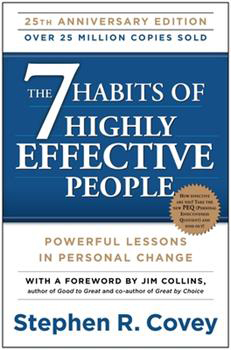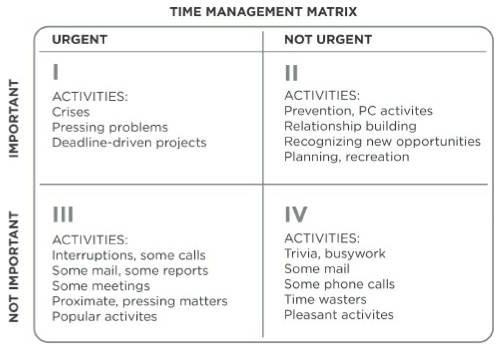Summarized by Lisa Buck
Book by Stephen R. Covey
 Chances are you have heard of The 7 Habits of Highly Effective People. There may even be a copy on your bookshelf. Since its publication in 1989, 7 Habits has been a consistent bestseller, and remains relevant 30+ years later.
Chances are you have heard of The 7 Habits of Highly Effective People. There may even be a copy on your bookshelf. Since its publication in 1989, 7 Habits has been a consistent bestseller, and remains relevant 30+ years later.
7 Habits author Stephen Covey identifies the principles or habits that lead individuals and organizations to effectiveness. “Effectiveness” is a function of two things:
1. What is produced: quality legal work, a favorable court outcome, or income, etc.
2. The capacity to produce: your legal team, resources, and business relationships, etc.
Covey calls this the “P/PC balance”. P stands for production of desired results. PC stands for production capability. Excessive focus on P leads to unhappy employees, broken relationships, and poor health. Excessive focus on PC leads to disappointing results. Effectiveness lies in the balance, and effectiveness is achieved by living according to 7 habits.
HABIT 1: Be Proactive
In Habit 1, we acknowledge that between stimulus (what happens to us) and response (what we do), we have the power to choose. Our behavior is a function of our decisions, not our conditions. Proactive people focus their efforts on their circle of influence, not their circle of concern.
Reactive people and organizations are circumstance-driven. In contrast, proactive people and organizations are value-driven.
Language can be an indicator of how reactive or proactive you are.
Reactive language includes statements such as: “I don’t have time,” “He makes me so mad,” “Employees won’t be productive if they work remotely,” or “There is no way we can be successful during a pandemic.” The speaker transfers responsibility to someone or something else. In contrast, proactive language might include: “Let’s look at the alternatives,” “I can choose my response,” “I can control my own feelings.”
Covey points to Viktor Frankl as an example of a proactive person. Frankl was tortured during the Holocaust and became a renowned psychiatrist and author, using his experience to become help others find meaning in their suffering.
HABIT 2: Begin with the End in Mind
The way you see time affects the way you spend time. In Habit 2, we view time with the end of our life or career as a frame of reference. Covey suggests imagining your funeral or retirement party. What would you want people to say about you?
Writing a personal or organizational mission statement can help us practice Habit 2. Focus on what you want to be and do. What contributions and achievements will you want to have made? Then integrate your mission statement into your life. Put the mission statement in your planner, phone, or desk so you can refer to it regularly.
HABIT 3: Put First Things First
In Habit 3, we organize and execute around our priorities. Covey recommends “scheduling your priorities” by organizing your schedule on a weekly basis using a four-step process:
1. Identify your key roles—Examples: parent, spouse, shareholder, mentor, board member
2. Select goals—Choose what you would like to accomplish in each role for the next 7 days
3. Schedule activities for the week, including delegation
4. Adapt daily due to unanticipated events
Covey uses a time management matrix to categorize activities and identify priorities. The matrix has four quadrants. One side of the matrix includes things that are urgent (requiring immediate attention) and not urgent. The other side of the matrix involves things that are important (things that are results-oriented and contribute to your goals/values) and not important.
Quadrant I includes activities that are both urgent and important, such as a project deadline or a health crisis. Quadrant II includes activities that are non-urgent but important. Examples include marketing, relationship building, long-range planning, and exercise.
Quadrant III includes activities that are not important but are urgent, such as some phone calls, emails, and meetings. Quadrant IV includes activities that are not important and not urgent, such as some social media, busy work, or fun things that do not contribute to your goals and values.
Prioritizing items in quadrant II will increase your effectiveness. Covey suggests asking yourself, “What is one thing that I am not doing now that could make a significant impact?” Most of the time, that thing belongs in quadrant II. In order to make time for items in quadrant II, we must decrease our time spent in quadrants III and IV. This may mean saying no to another board membership or deleting a social media app that is a time waster.

HABIT 4: Think Win/Win
In Habit 4, we adopt a win/win attitude. Win/win is a frame of mind that constantly seeks mutual benefit in interactions. It views life as a cooperative, rather than competitive, arena. This is challenging in an adversarial profession like the law. Win/win involves having an abundance mentality, which is believing there is enough for everyone.
Win/win involves 4 steps:
1. See the problem from the other’s point of view
2. Identify key issues and concerns—not positions
3. Determine what results would be an acceptable solution
4. Identify possible new options to achieve those results
HABIT 5: Seek First to Understand
In Habit 5, we seek to understand the other person. In other words, listen to understand the other’s needs and concerns before rushing to solve a problem. Covey calls this “diagnosing before prescribing.” He uses an eyeglasses analogy. If someone complained they can’t see well, would you put your own eyeglasses on them? No. Seek first to understand their concerns.
Habit 5 requires empathic listening. This is active listening with our ears, eyes, and heart, with intent to understand. Empathic listening includes rephrasing the content you heard and reflecting the feeling behind the words.
HABIT 6: Synergize
In Habit 6, we seek synergy, which is a condition of the whole being greater than the sum of the parts. Synergy involves valuing differences and seeking third alternatives. Synergy releases creative energy, leading to better solutions than either party originally suggested. Practice synergy by saying, “You see it differently. Help me understand.” With a compromise, both parties are giving something up, and the ultimate product isn’t as high value. Whereas with synergy, everyone seeks alternative solutions that end up being better than any of the original ideas and produces more value.
Covey uses these equations to show the difference between compromise and synergy.
Compromise: 1 + 1 = 1.5
Synergy: 1 + 1 = 3 or more
HABIT 7: Sharpen the Saw
In Habit 7, we make time for balance and self-renewal. This is an investment in self. Covey uses a saw as an analogy. A person that is trying vigorously to cut a tree down with a dull saw would be foolish to say, “I don’t have time to sharpen the saw, I’m too busy sawing.” Likewise, it is important to strengthen yourself physically, socially, spiritually, and emotionally. Covey suggests devoting one hour per day to Habit 7 activities. He calls this a “daily private victory” which he practiced until his death in 2012.
Practicing these 7 habits can help us balance our desired results and our capability to produce those results, increasing our effectiveness at work and in life.
.jpg?sfvrsn=131ddd97_2) Ms. Buck practiced corporate law in Minneapolis and was an adjunct professor at William Mitchell College of Law. When she isn’t writing for the Hennepin Lawyer, you can find her behind the lens at Lisa Buck Photography.
Ms. Buck practiced corporate law in Minneapolis and was an adjunct professor at William Mitchell College of Law. When she isn’t writing for the Hennepin Lawyer, you can find her behind the lens at Lisa Buck Photography.
buck.lisamarie@gmail.com
By Lisa Buck
buck.lisamarie@gmail.com
Ms. Buck practiced corporate law in Minneapolis and was an adjunct professor at William Mitchell College of Law. When she isn’t writing for the Hennepin Lawyer, you can find her behind the lens at Lisa Buck Photography.
By Lisa Buck
buck.lisamarie@gmail.com
Ms. Buck practiced corporate law in Minneapolis and was an adjunct professor at William Mitchell College of Law. When she isn’t writing for the Hennepin Lawyer, you can find her behind the lens at Lisa Buck Photography.
By Lisa Buck
buck.lisamarie@gmail.com
Ms. Buck practiced corporate law in Minneapolis and was an adjunct professor at William Mitchell College of Law. When she isn’t writing for the Hennepin Lawyer, you can find her behind the lens at Lisa Buck Photography.